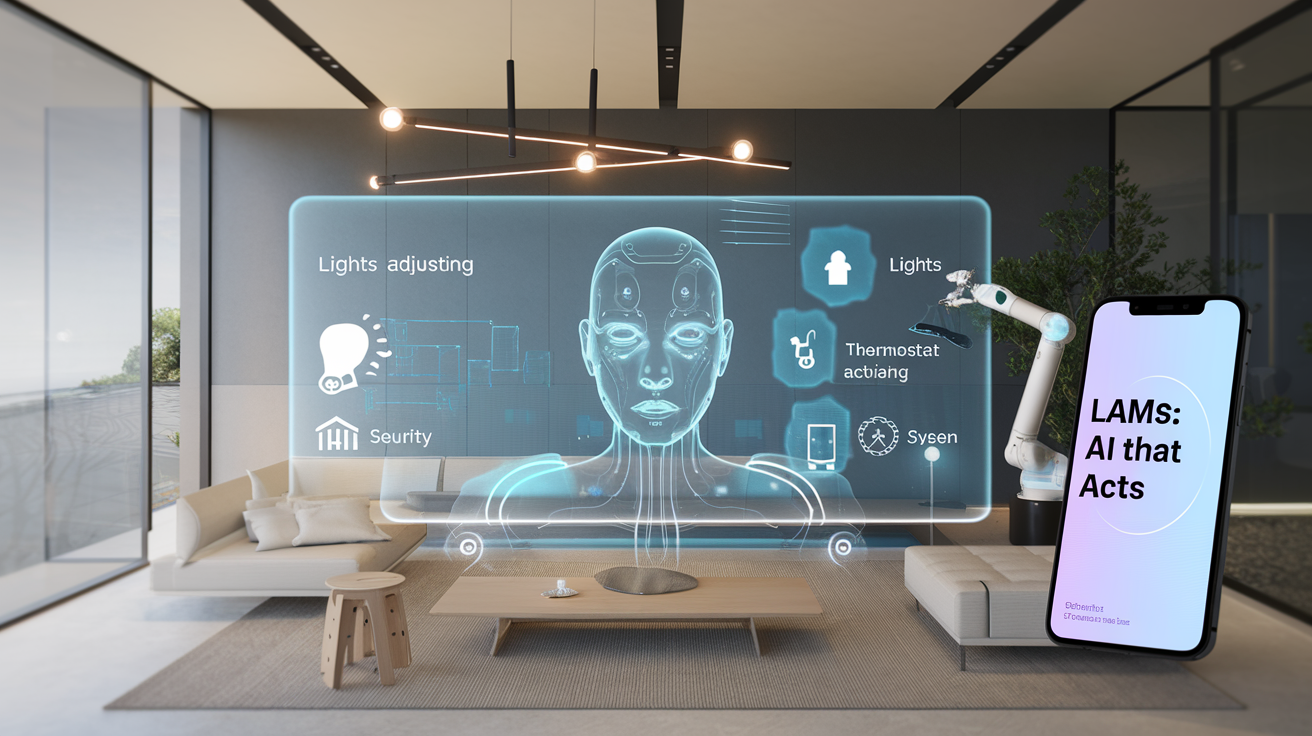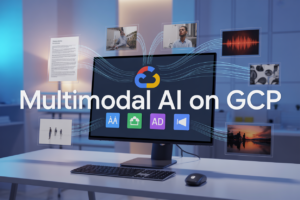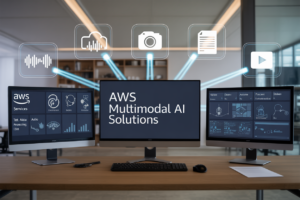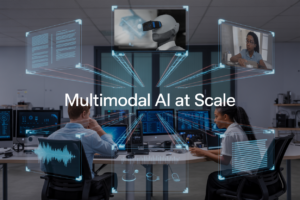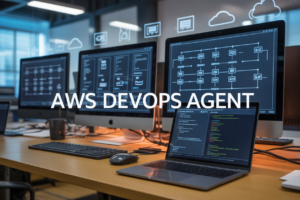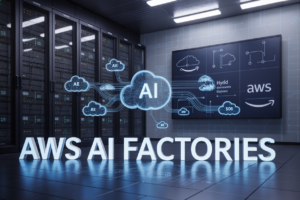Ever watched an AI generate a Renaissance-style portrait of your pet goldfish in under 10 seconds? Five years ago, that would’ve sounded like science fiction. Now it’s just Tuesday.
The machines aren’t just coming – they’re creating, composing, and sometimes confusing us all with their uncanny abilities. Generative AI is transforming how we produce content across every medium imaginable.
By the end of this guide, you’ll understand exactly how these systems take random noise and mathematical patterns and somehow turn them into coherent text, stunning visuals, and even music that could pass for human-made.
But here’s the million-dollar question that keeps AI researchers up at night: when a machine creates something truly original, who really deserves the credit? And is that even the right question to be asking?
Defining Generative AI: The Magic Behind Machine Creativity
How generative AI differs from traditional AI systems
Traditional AI plays by strict rules – it’s all about inputs and outputs. But generative AI? It’s the creative rebel. These systems don’t just follow instructions; they dream up entirely new content based on what they’ve learned. They don’t merely predict or classify – they imagine and create. That’s the game-changer.
The foundation technologies powering generative models
Generative AI isn’t built on wishes and fairy dust. It’s powered by some serious tech muscle:
- Neural Networks: Specifically deep learning architectures that can process and learn from massive datasets
- Transformer Models: The breakthrough architecture behind systems like GPT and BERT, using attention mechanisms
- Diffusion Models: The magic behind many image generation systems like DALL-E and Stable Diffusion
- Generative Adversarial Networks (GANs): Two neural networks competing to produce better results
The secret sauce is how these technologies work together to understand patterns, relationships, and structures in data, then create something new that never existed before.
Key milestones in generative AI development (2017-2025)
| Year | Milestone | Why It Matters |
|---|---|---|
| 2017 | GANs hit mainstream | Introduced adversarial training for realistic image generation |
| 2018 | GPT-1 released | Showed language models could generate coherent text |
| 2020 | GPT-3 shocked the world | Demonstrated emergent abilities at scale (175B parameters) |
| 2021 | DALL-E & CLIP | Connected text and images in new ways |
| 2022 | Stable Diffusion & ChatGPT | Democratized access to generative AI tools |
| 2023 | Multimodal systems matured | AI systems began working across text, image, audio, and video |
| 2024 | Agent-based systems emerged | AI could take actions based on generated plans |
| 2025 | Real-time generative systems | Enabling instantaneous creative collaboration |
Why generative AI matters in today’s digital landscape
Generative AI isn’t just another tech fad – it’s fundamentally reshaping how we interact with technology. From content creation to product design, healthcare research to education, these systems amplify human creativity rather than replacing it.
Businesses are finding competitive advantages through personalization at scale. Creators are exploring entirely new art forms. And everyday users are discovering tools that turn their ideas into reality without specialized technical skills.
The most profound impact? Generative AI is democratizing creation itself, making the ability to produce professional-quality content accessible to nearly everyone with an internet connection.
The Science of Text Generation
The Science of Text Generation
A. Understanding large language models (LLMs)
Ever wondered how ChatGPT seems to understand what you’re asking? LLMs are massive neural networks trained on billions of text examples. They don’t actually “understand” language like humans do—they’re pattern-matching machines that predict which words should follow others based on probabilities. Pretty wild when you think about it.
AI-Generated Visual Art: A Digital Renaissance
AI-Generated Visual Art: A Digital Renaissance
A. How image generation models interpret text prompts
AI art generators have transformed blank pixels into masterpieces by learning to “see” our words. These models break down text prompts into key concepts, matching phrases to visual elements they’ve learned from millions of images. The magic happens when algorithms translate “sunset over mountains” into color gradients, shapes, and textures that look surprisingly human-made.
Beyond Text and Images: The Expanding Universe of Generative AI
Beyond Text and Images: The Expanding Universe of Generative AI
A. AI-composed music and sound design
Gone are the days when AI just spat out text and images. Now these smart systems are composing symphonies that’ll make Mozart jealous. Tools like OpenAI’s Jukebox and Google’s MusicLM aren’t just mimicking music – they’re creating original compositions that blur the line between human and machine creativity. Some musicians are even collaborating with these AI composers, finding inspiration in the unexpected melodies and harmonies they generate.
B. Video generation technologies and their potential
Video generation AI is having a moment, and it’s wild. Imagine describing a scene in words and watching as an AI conjures it into moving images. That’s exactly what tools like Runway ML and Synthesia are doing. Marketing teams are ditching expensive video shoots for AI-generated content. Filmmakers are using these tools to visualize scenes before shooting. The tech isn’t perfect yet – those weird AI hands are still a dead giveaway – but it’s improving at breakneck speed.
C. 3D model creation and virtual environment design
AI is revolutionizing 3D creation, turning “I can’t even draw a stick figure” folks into digital sculptors overnight. Tools like NVIDIA’s GET3D and Google’s DreamFusion transform text prompts into detailed 3D models. Game developers who once spent weeks modeling environments now generate entire worlds in hours. Architects visualize buildings before laying a single brick. The metaverse builders? They’re using these tools to craft digital realms at unprecedented scale and speed.
D. Code generation and software development assistance
Coding is getting a serious AI upgrade. GitHub Copilot and Amazon CodeWhisperer are like pair-programming with a partner who’s memorized the entire Stack Overflow. These tools don’t just auto-complete – they suggest entire functions, debug your mess, and explain what the heck that mysterious error means. Junior developers are leveling up faster, and seasoned coders are focusing on architecture while AI handles the boilerplate. It’s not replacing programmers – it’s supercharging them.
E. Multimodal systems combining different creative capabilities
The real magic happens when these AI systems start talking to each other. Multimodal AI like OpenAI’s GPT-4V and Anthropic’s Claude 3 don’t just understand text – they see images, analyze videos, and generate responses across different formats. Imagine describing a product, having AI create its image, compose a jingle, generate marketing copy, and build a simple website – all from one prompt. These systems aren’t working in isolation anymore; they’re creating an ecosystem of AI creativity that’s greater than the sum of its parts.
Practical Applications Transforming Industries
Practical Applications Transforming Industries
A. Content creation and marketing automation
Ever watched an AI write a blog post in seconds? That’s just the beginning. Marketing teams are now deploying generative AI to create everything from email campaigns to social media posts at scale. The technology doesn’t just save time—it’s revolutionizing how brands connect with audiences through personalized content that once required entire creative departments.
B. Product design and prototyping breakthroughs
Designers are ditching traditional sketching for AI-powered alternatives that transform rough concepts into polished prototypes instantly. A product developer can now describe a chair in plain English and watch as the AI generates dozens of variations, complete with material specifications and structural analysis. This isn’t just faster design—it’s unlocking creativity we never knew existed.
C. Entertainment and media production innovations
Hollywood has a new favorite tool, and it’s changing everything behind the scenes. Film studios use generative AI to visualize scenes before shooting, musicians collaborate with algorithms to create backing tracks, and game developers build entire worlds from text prompts. The barrier between imagination and creation has never been thinner, with AI turning “what if” into “what now.”
D. Educational tools and personalized learning experiences
The one-size-fits-all education model is crumbling as generative AI creates custom learning paths for every student. Struggling with algebra? Your AI tutor adapts in real-time, presenting problems matched to your learning style. Language learning apps now generate natural conversations about your personal interests, while professors use AI to create unique assignments that target individual growth areas.
Getting Started with Generative AI Tools
User-friendly platforms for beginners
Ever tried making AI art but got lost in techno-babble? Start with DALL-E or Midjourney for images, or ChatGPT for text. No coding needed! These platforms come with intuitive interfaces where you simply type what you want and watch the magic happen. Perfect for your first AI creation adventure.
Tips for crafting effective prompts
The secret sauce of great AI output? Your prompts. Be specific—”create a watercolor painting of a coastal Italian village at sunset with boats in the harbor” beats “make a nice picture.” Try adding style references, emotions, or technical details. And don’t give up after one try! Refining prompts is like learning a new language—practice makes perfect.
Integrating generative AI into your workflow
AI tools aren’t just toys—they’re time-savers. Writers can overcome blocks with AI-generated outlines. Designers can kickstart projects with AI mockups. Marketers can draft multiple content versions in minutes. Start small: identify one repetitive task in your work and let AI handle the first draft while you focus on refinement and creativity.
Resources for learning more advanced techniques
Ready to level up? The AI community is incredibly generous with knowledge. Check out Hugging Face’s tutorials for technical deep-dives. Join Discord communities for Midjourney or Stable Diffusion where pros share tips daily. Follow AI creators on YouTube like Two Minute Papers or Prompt Engineering. Online courses from platforms like Coursera offer structured learning paths with practical exercises.
The Future Landscape of Generative AI
Emerging capabilities and research frontiers
AI researchers are pushing boundaries daily. The next wave of generative models will likely understand context better, create longer coherent narratives, and blend multiple creative disciplines seamlessly. We’re seeing early signs of AI that can maintain consistent characters across stories and generate multi-episode content autonomously.
How generative AI will reshape creative professions
Creative professionals won’t disappear—they’ll transform. Designers are becoming prompt engineers and creative directors. Artists focus more on concept and curation while AI handles execution. The value shifts from technical skill to taste, judgment, and the uniquely human ability to evaluate aesthetic quality.
Addressing limitations and technical challenges
Current models struggle with factual accuracy and logical reasoning. They hallucinate details and lack understanding of physical laws. Researchers are tackling these issues through better training data, improved architectures, and developing systems that can verify their own outputs against reality.
Preparing for the democratization of creative AI
The gates are opening. Tools that once required technical expertise now work with simple prompts. Small businesses can create professional-quality assets without design teams. Education must evolve—teaching humans to collaborate with AI rather than compete against it.
Generative AI has emerged as a revolutionary force, transforming how we create content across multiple domains. From producing human-like text through sophisticated language models to generating stunning visual art and music, these systems have democratized creativity in unprecedented ways. The practical applications span across industries—from content creation and marketing to healthcare and scientific research—offering tools that enhance productivity and unlock new creative possibilities.
As we stand at the frontier of this technological revolution in mid-2025, both individuals and organizations have numerous accessible entry points to begin experimenting with generative AI tools. Whether you’re a curious beginner or an industry professional, the expanding ecosystem of user-friendly applications makes this technology increasingly approachable. While challenges around ethics, authenticity, and copyright remain important considerations, generative AI’s continued evolution promises to further blur the lines between human and machine creativity—creating a future where AI becomes not just a tool, but a collaborative partner in our creative endeavors.










